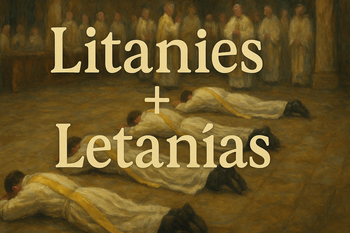Receive God's Love, Proclaim the Greatness of the Lord, Serve Joyfully & Make Missionary Disciples of Jesus Christ
-

LITURGY CORNER
Liturgical Prayers: Litanies
One of the various forms of prayers are Litanies which in a general sense includes a repeated phrase between various other words. We have two litanies that occur at almost all Masses. The Kyrie (Lord, have mercy) and the Agnus Dei(Lamb of God). In one of the forms of penitential act, petitions are added between each iteration of the Lord have mercy & Christ have mercy. The Agnus Dei typically has three repetitions with the repeated part starting- Lamb of God you take away the sins of the world and the second part changing- have mercy on us/grant us peace. Prior to the 2010 revision of the Roman Missal it was not odd to have a variety of invocations at the start of the Lamb of God. For example, Bread of life you take away, cup of mercy, you take away, etc…
Most likely the earliest litany comes from the book of psalms. In Psalm 136 there is a repeated phrase “for his mercy endures forever.” I wonder if this proto-litany the reason for the inclusion of pleading for God’s mercy in both the Kyrie & Agnus Dei. The Catholic Church has used litanies since the fourth century, most commonly as prayers of petition and in procession related to rogation days (a topic for another article).
Vatican II followed a principle of clarifying liturgical practices that had become a little bloated. One area that needed clarification was indulgences (spiritual acts to reduce time in purgatory for our sins). The public praying of litanies could yield indulgences. Vatican II limited the list of indulgenced litanies to six- Saints, Sacred Heart, Holy Name, Precious Blood, Blessed Virgin, and Saint Joseph. The only one of these litanies that makes a formal appearance in liturgies of the church is the Litany of Saints which is a part of Baptismal liturgies including the Easter Vigil. It is also a part priest and deacon ordinations during which those to be ordained lie prostrate during the litany. These formal litanies also include the kyrie and the lamb of God within them.
There are many more litanies and you could even compose one yourself. These are intended for private use (personal or even small groups) but not as a formal part of the church's liturgies. The structure of litanies make them great for participation of all gathered because the responses are usually brief and fairly consistent. That is probably why historically they were used in processions, so people could be unified in their prayer when spread across long distances. Consider looking for a litany that resonates with you and praying it a few times this week. Additionally our devotions teams tries to pray the public litanies close to associated feast days. Learn more at www.mqhr.org/litanies
RINCÓN DE LA LITURGIA
Oraciones litúrgicas: Letanías
Una de las diversas formas de oración son las Letanías, que, en sentido general, incluyen una frase repetida entre varias palabras. Existen dos letanías que se repiten en casi todas las misas: el Kyrie (Señor, ten piedad) y el Agnus Dei (Cordero de Dios). En una de las formas de acto penitencial, se añaden peticiones entre cada iteración de "Señor, ten piedad" y "Cristo, ten piedad". El Agnus Dei suele tener tres repeticiones; la parte repetida comienza con "Cordero de Dios, que quitas los pecados del mundo" y la segunda parte cambia: "Ten piedad de nosotros/concédenos la paz". Antes de la revisión de 2010 del Misal Romano, no era extraño tener diversas invocaciones al comienzo del Cordero de Dios. Por ejemplo, "Pan de vida que quitas", "Cáliz de misericordia que quitas", etc.
Probablemente la letanía más antigua provenga del libro de los Salmos. En el Salmo 136 hay una frase repetida: "Porque para siempre es su misericordia". Me pregunto si esta protoletanía es la razón por la que se incluye la súplica de la misericordia divina tanto en el Kyrie como en el Agnus Dei. La Iglesia católica ha usado letanías desde el siglo IV, comúnmente como oraciones de petición y en procesiones relacionadas con los días de rogativas (tema para otro artículo).
El Vaticano II siguió el principio de clarificar las prácticas litúrgicas, que se habían vuelto algo excesivas. Un área que necesitaba aclaración eran las indulgencias (actos espirituales para reducir el tiempo en el purgatorio por nuestros pecados). El rezo público de letanías podía otorgar indulgencias. El Vaticano II limitó la lista de letanías indulgenciadas a seis: Santos, Sagrado Corazón, Santo Nombre, Preciosa Sangre, Santísima Virgen y San José. La única de estas letanías que aparece formalmente en las liturgias de la iglesia es la Letanía de los Santos, que forma parte de las liturgias bautismales, incluida la Vigilia Pascual. También forma parte de las ordenaciones de sacerdotes y diáconos, durante las cuales los ordenados permanecen postrados durante la letanía. Estas letanías formales también incluyen el kyrie y el cordero de Dios.
Hay muchas más letanías, e incluso se puede componer una propia. Estas están destinadas al uso privado (personal o incluso en grupos pequeños), pero no como parte formal de las liturgias de la iglesia. La estructura de las letanías las hace ideales para la participación de todos los reunidos, ya que las respuestas suelen ser breves y bastante consistentes. Probablemente por eso se usaban históricamente en procesiones, para que la gente pudiera unirse en su oración incluso a grandes distancias. Considere buscar una letanía que le resuene y rezarla varias veces esta semana. Además, nuestros equipos de devoción intentan rezar las letanías públicas cerca de las festividades asociadas. Obtenga más información en www.mqhr.org/litanies
